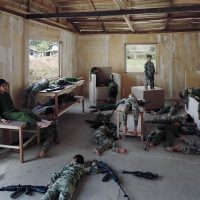The five channels of the installation, recorded in Laos, are organized in a long frieze, consisting of one central image flanked by two vertical and two horizontal ones.
They alternate between archetypical scenes of warfare, referring to television and video games, and images from nature – a waterfall, an island and a Spirit Tree – which relate to spiritual life in Laos.
The warfare scenes, enacted by children and Marina Abramović herself, encourage compassion and responsibility. The title of the work refers to the traditional Buddhist notion of emptiness – emptying the mind to allow transformation to a different state, in this case to achieve purification through the viewing process.
Ideologically, ‘8 Lessons on Emptiness with a Happy End’ differs from most political-activist contemporary work, which usually has an opposing quality; here, Marina Abramović calls for compassion, critiques violence and its representation, and offers an opportunity for redemption.
As a special feature of the Budapest exhibition, by courtesy of the artist and Galerie Guy Bärtschi in Geneva, a few of the original drawings that were made in preparation for the video installation are also on view, as well as the maquette of the house that was built for the project and served as the setting for the video shoot.

